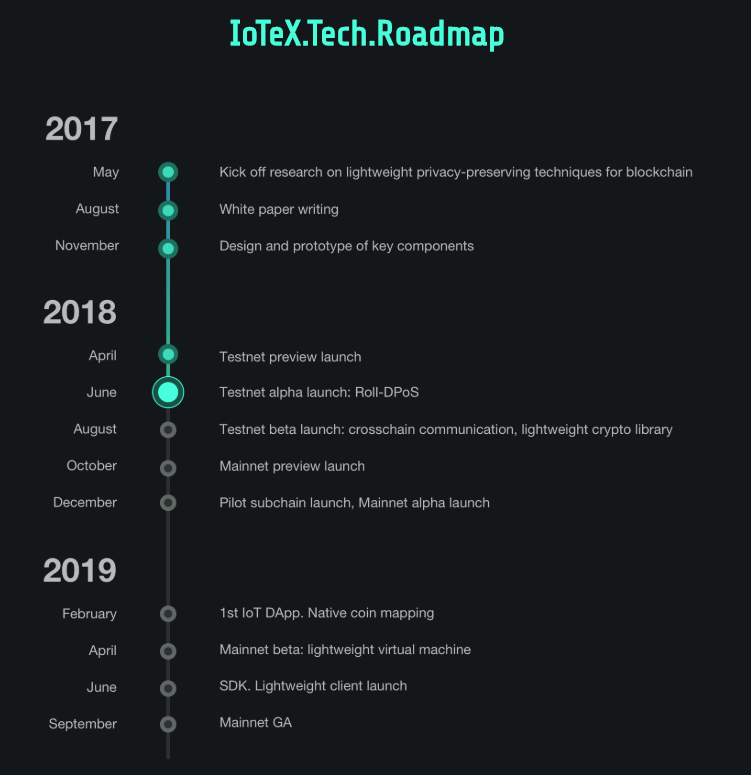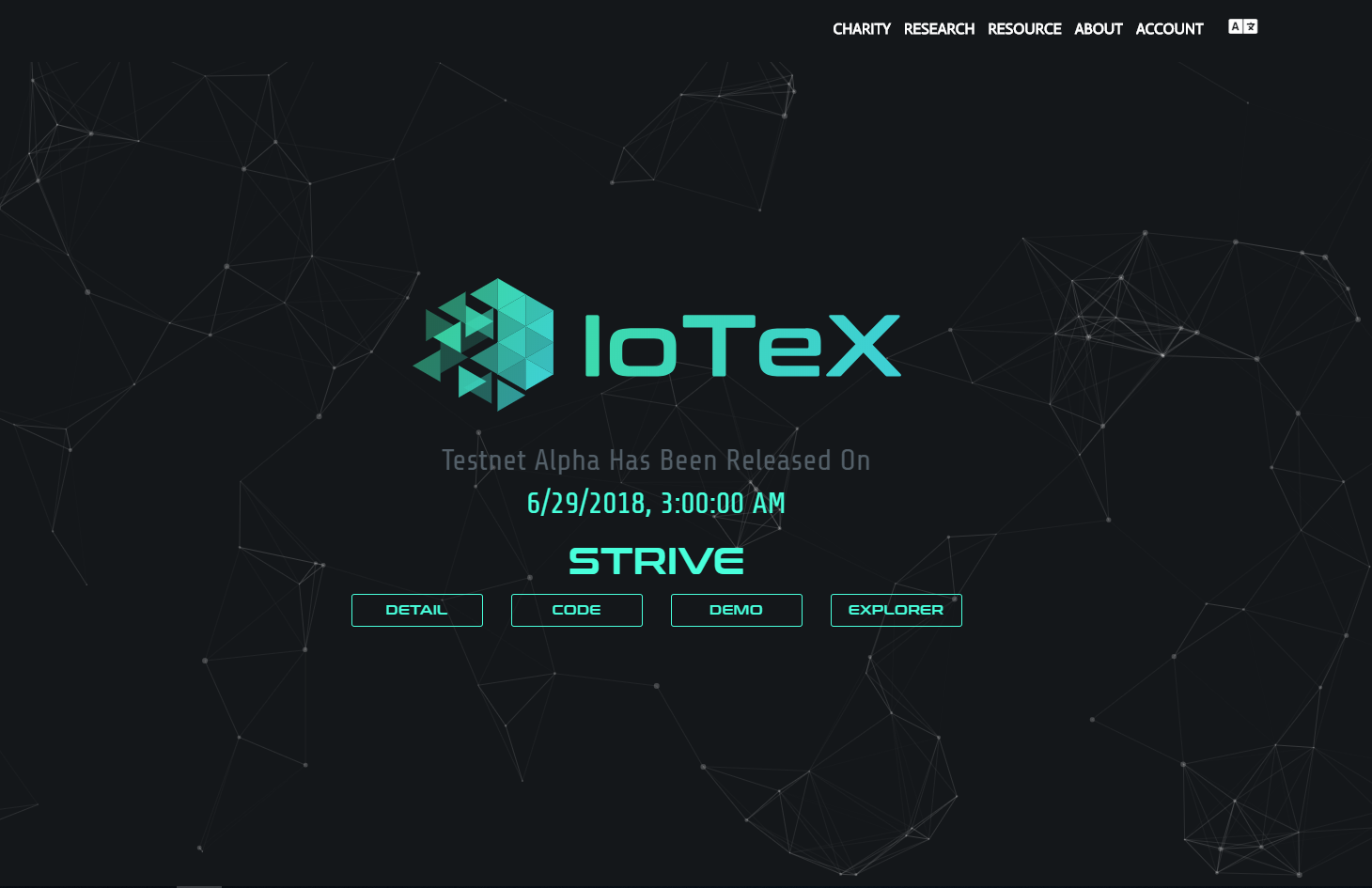IoTeX (IOTX) Review – Connecting the Physical World, Block by Block
| Name | IoTeX |
| Ticker | IOTX |
| Token Type | ERC-20 |
| Total Supply | 10,000,000,000 |
| Private Sale Price | $0.007 |
| Category | Privacy-centric Blockchain |
| Website URL | https://iotex.io |
| White Paper URL | https://iotex.io/white-paper |
IoTeX is the scalable and private blockchain infrastructure for the Internet of Things (IoT) customized for IoT by leveraging a blockchain-in-blockchain architecture. It is connecting the physical world together, block by block with its quick and efficient Roll-DPoS consensus scheme and lightweight privacy-preserving techniques.
The Idea and the Team Behind IoTeX
According to recent data from Juniper Research, the number of connected Internet of Things (IoT) sensors and devices should exceed 50 billion by 2022. With this explosion in IoT comes the need for secure methods to automate processes as well as exchanging information in real-time.
Currently the major challenges that are delaying the mass adoption of IoT include: scalability; lack of privacy; high operating costs, and lack of functional value. IoTeX aims to meet these challenges with a flexible, privacy-centric blockchain infrastructure that leverages its own fast consensus mechanism based on delegated proof-of-stake in addition to the use of subchains.
Some of IoTeX’s competitors, such as IOTA, use DAG (Directed Acyclic Graph) to solve the challenge of scalability as well as deliver a lightweight solution for low power devices. The problem is that it does this at a price: global consensus. IoTeX believes this is too high a price to pay. Instead, it seeks to design a blockchain architecture with multiple blockchains, a root one responsible for governance of the entire network, and sidechains that have different purposes, such as transactions with autonomous vehicles (think Uber).
The IoTeX team has vast experience in both cryptocurrency and cryptography. Co-founder Raullen Chai has a PhD in cryptography and is currently a research scientist at the University of Waterloo. He was formerly the head of cryptography R&D at Uber as well as a security engineer at Google. Co-founder Qevan Guo also has a PhD in machine learning and computer vision from the National University of Singapore. He was also an engineering manager and research scientist at Facebook. Jing Sun is the third co-founder, with experience leading over 40 investments in blockchain, security, and IoT. She has sat on the board of various companies, and is the founder partner of Sparkland Capital, a venture capital firm focused on connecting Silicon Valley and Asia.
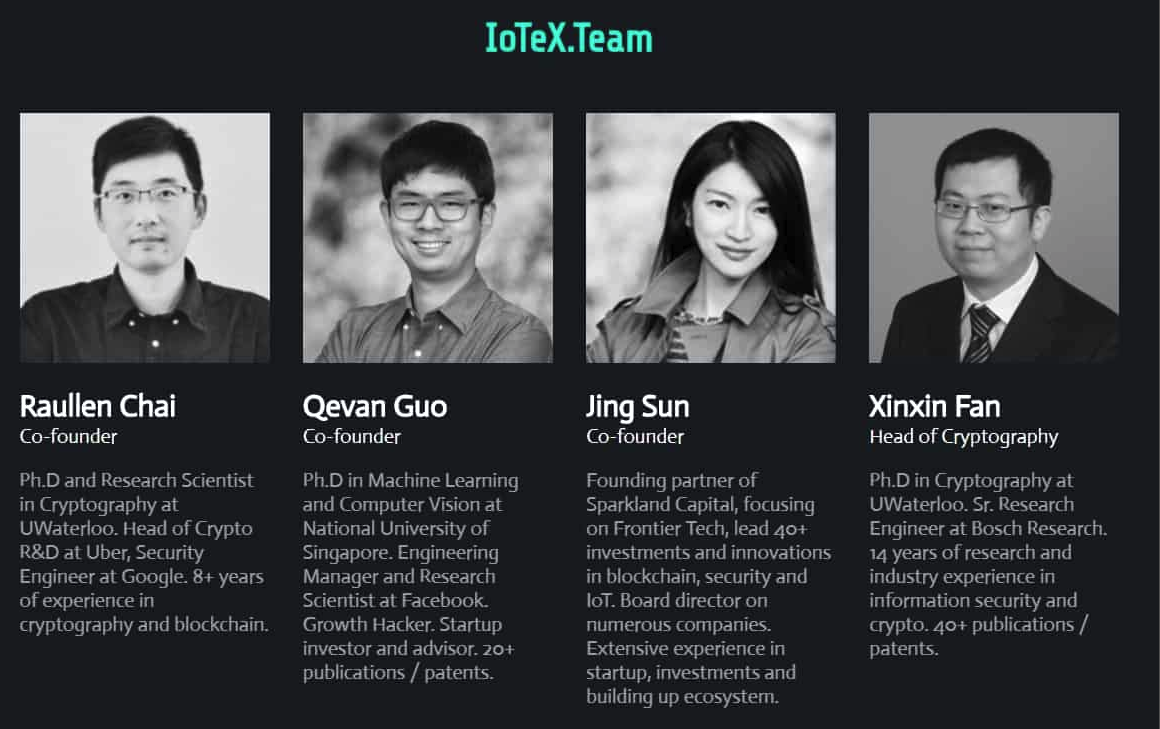 IoTeX Partnerships
IoTeX Partnerships
IoTeX has a number of strategic partnerhips and investors, including the Blockchain Foundation and blockchain industry service platform Jinse. In June it announced a partnership with CertiK, a leader in formal verification and security of smart contracts. Together the two companies will ensure their blockchain and smart contracts are completely secure.
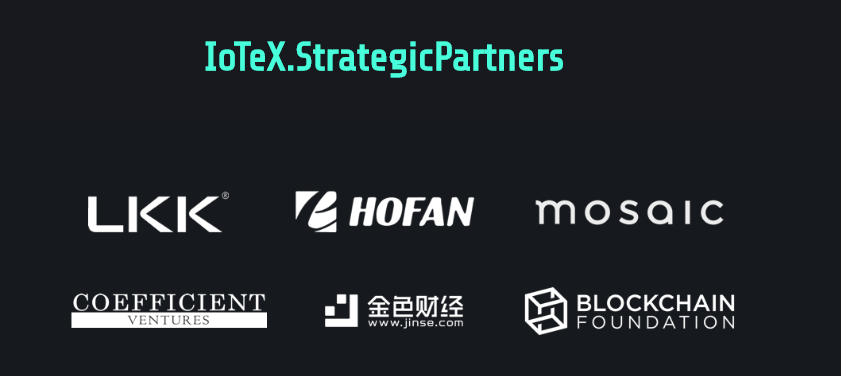
IoTeX Price History
IoTeX raised around $14 million in private funding. The initial price of the token was $0.0070 but rose to $0.067 by early June, coinciding with the token’s listing on Binance. The token price rose again later in June to $0.047 after the announcement of IoTex’s partnership with CertiK.
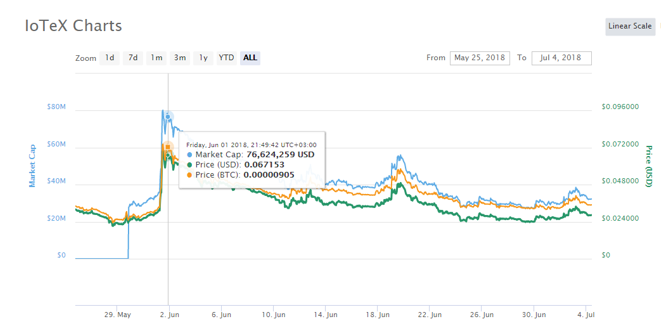
The IoTeX Technology
IoTeX’s design architecture is aimed to become the privacy-centric and scalable spinal cord and nervous system for IoT. The architecture design includes the following:
Separation of Duties
Since different IoT applications need to use different features of a blockchain, putting IoT nodes into one single blockchain is not practical. In addition, having all IoT nodes in one blockchain makes it grow quickly in size and computation and become too heavy for IoT devices.
Instead, an alternative is proposed: A separation of duties. That means that each blockchain will interact with a specific group of IoT nodes, which also interact with other blockchains when necessary. This separation of duties maximizes efficiency and privacy.
Occam’s Razor
Occam’s razor is a principle that says that the simplest solution is often the right one. As applied to IoTeX, it means that the separate blockchains have different uses and applications and each must be designed with this idea in mind. For examples, blockchains used for relaying transactions don’t need Turing-complete contracts, which implement sophisticated logic.
IoT-Friendly
The blockchain for IoT must be designed to minimize resources such as computations, storage and energy.
One of the unique features of IoTeX is that it enables blockchains to run concurrently with one another while retaining interoperability. This is done through the development of their root blockchains and subchains.
Root Blockchains and Subchains
In the IoTeX architecture, a root blockchain exists which manages separate blockchains, or subchains. Subchains connect IoT devices with a similar functional purpose, as well as those that operate in similar environments, or have a similar level of trust. The benefit of a subchain is that if it is attacked, the rootchain stays unaffected.
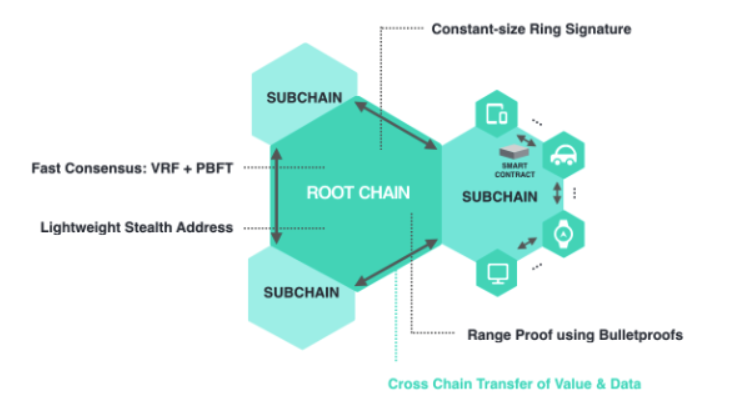
The rootchain and subchains within the IoTeX network are also referred to as a “blockchain within a blockchain.”
Cross-Blockchain Communication
The IoTex protocol allows for quick, efficient, and cost-effective cross-blockchain communication. It includes pegging, a mechanism for scaling the Bitcoin network via sidechains, and block finality. Block finality guarantees that the new block generated is final and cannot be changed. Although most public blockchains like Bitcoin don’t have instant finality, IoTeX’s consensus mechanism achieves instant block finality.
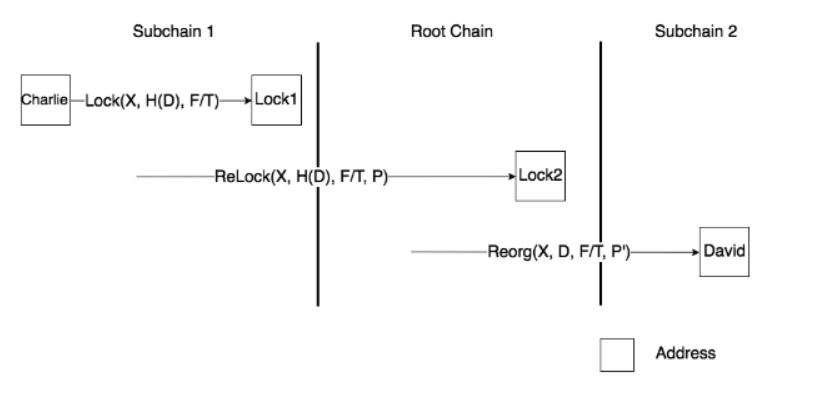
Cross-Blockchain Transactions
Built-in Privacy-Preserving Transaction
The privacy that Bitcoin and Ethereume provides is only in the form of pseudonymity. IoTeX offers a lightweight stealth address scheme so that receivers don’t have to scan the entire system to be aware of incoming transactions. In addition, it offers a ring signature that is optimized with a distributed trusted setup. To maximize privacy even further, IoTeX designed a relayable payment code that hides the transaction receiver.
The IoTeX Yellow Paper on Roll-DPoS Consensus Mechanism
The Delegated Proof-of-Stake framework gives stakeholders authority to elect a number of network nodes as block producers. These representatives are then responsible for generating and adding blocks to the blockchain. Rewards are given back to the stakeholders. This is a continuous process that incentivizes representatives to continue to produce blocks.
DPOS has its flaws, however. The first is that it cannot achieve decentralization due to the static nature of its representatives. Secondly, the framework cannot handle complex blockchain architectures with multiple large-scale blockchain applications that run at the same time.
The solution that IoTex proposes is Randomized Delegated Proof of Stake (Roll-DPoS), which is the combination of a few concepts: DPoS, Practical Byzantine Fault Tolerance (PBFT) and Verifiable Random Functions (VRFs). The Roll-DPoS consensus mechanism allows mass scalability and a more decentralized approach than traditional DPoS. More technical details can be seen in their Yellow Paper.
The IoTeX Tokens
The total number of IoTeX tokens will be 10 billion tokens. The tokens will originally be ERC-20 tokens (IoTX) and will be switched to the native IoTeX token (IOX) which will be mineable for the next 50 years. Rewards will be reduced over time, based on a linear gradient reduction model.
After the mainnnet launch, the token will be used to power the IoTeX network, including executing transactions and running distributed apps on the IoTeX blockchain. It will be a non-refundable utility token that will be used as the method of exchange between participants on the IoTeX network.
The tokens will be distributed as follows:
- Private Sale – 24% of the total supply
- Community Reward Programs – 6% of the total supply
- Team – 15% of the total supply
- Ecosystem – 30% of the total supply
- Foundation – 25% of the total supply
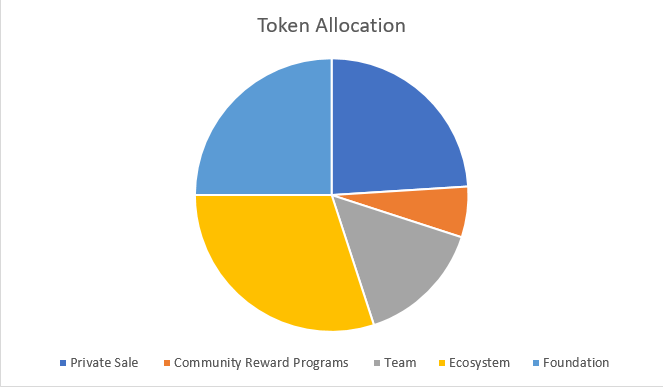
How to Purchase IoTX
The main way to purchase IoTX is through Binance, either through trading bitcoin or ether. Binance currently has the largest volume of IoTX trading and allows you to purchase it with either BTC or ETH.
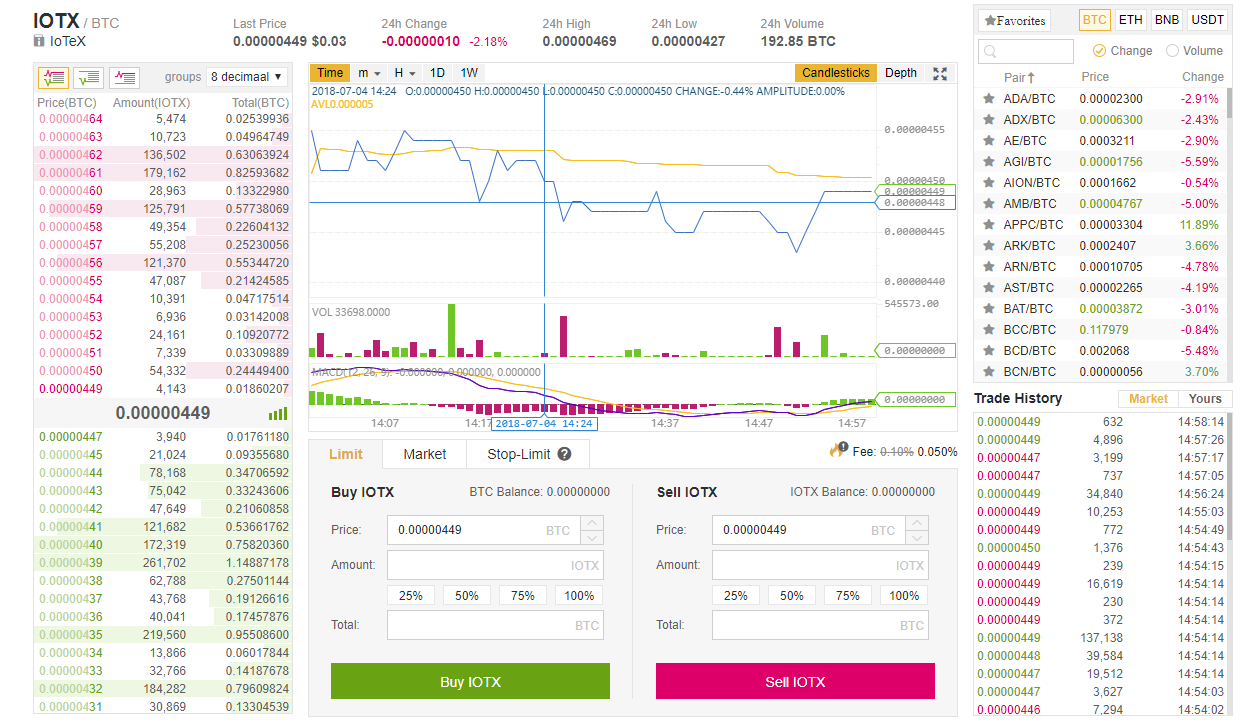
IOTX is also available on the following exchanges:
- io (Trade IOTX with USDT on Gate.io)
- io (Trade IOTX with ETH on Gate.io)
- Kucoin (Trade IOTX with BTC on Kucoin)
- Kucoin (Trade IOTX with ETH on Kucoin)
- IDEX (Trade IOTX with ETH on IDEX)
How to Store IoTX
IoTX can be stored in any wallet that supports ERC-20 tokens such as Coinomi, MetaMask and Myetherwallet.
For maximum security, however, you should store your IoTX on hardware wallets such as Ledger Nano S and Trezor.
Roadmap and Future Updates
The company has a detailed roadmap, including its mainnet preview in October and launch in December 2018. It recently released its Yellow Paper on Roll-DPoS, their in-house randomized DPoS consensus mechanism in July.
In early 2019, it is scheduled to have the first IoT DApp and native coin mapping, in addition to a mainnet beta.
IoTeX is currently working on its testnet alpha launch and Roll-DPoS. It has also announced that it is working on building sub-communities in different languages to provide better services to the community. This includes a Korean channel, which is currently ready for users to join.